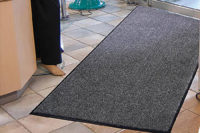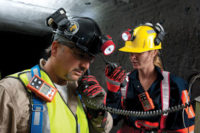Last year, in British Columbia, Canada, there was a major combustible dust explosion that killed one man and injured 24 workers, nine of them with serious or critical injuries. It launched a fireball more than 200 feet high, according to reports… and alarmingly, this was the second lumber mill explosion and fire in four months.
And, in 2011, OSHA fined a New Hampshire wood pellet manufacturer almost $150,000 because of “repeated and serious violations” leading to two combustible dust explosions since 2008. In one of the explosions and fires, more than 100 firefighters from 14 nearby towns were called in to fight the blaze, which took 15 hours to extinguish.
Differences among dust
OSHA, in the simplest of terms, defines combustible dust as fine particles of dust that present a “flash” or explosion hazard when suspended in air under certain conditions. However, the explosibility of the dust — in other words, the likelihood of the dust actually exploding — can be influenced by such factors as its size and shape, how moist or dry it is, as well as conditions in the indoor and outdoor environments.
Additionally, not all combustible dust is created equally. Different types have what are referred to as “Kst” values, which can also be used to determine how likely the dust will explode. For instance, according to OSHA, wood dust has a Kst value of more than 200, but less than 300, indicating it has “strong explosion” characteristics. Aluminum and magnesium dust have even higher Kst values at more than 300, indicating “very strong” explosion characteristics. However, even if a dust type has a relatively weak Kst value, such as sugar which is rated at less than 200, an explosion is still possible.
Common triggers
Although different types of dust have varying explosion characteristics, and factors such as size and Kst value can influence the likelihood of a combustible explosion, exactly how or why an explosion occurs requires further explanation.
In order to start a fire, which can be caused by or be the result of a dust explosion, what is known as a “Classic Fire Triangle” must first form. This means the following three key elements are present: fuel, which is the combustible dust; ignition, usually referencing heat or something that triggers the explosion; and oxygen in the air.
An additional two elements are required to have a combustible dust explosion. These are:
- Suspension of the dust particles in sufficient quantity and concentration
- Confinement of the dust cloud within the facility.
If any of these five elements are missing, a combustible dust explosion will likely not occur.
Effective housekeeping
According to OSHA, proper housekeeping in industrial locations can play a significant role in reducing combustible dust explosions. In fact, the administration has increasingly emphasized housekeeping infringements when issuing citations.
For instance, one OSHA citation indicated the facility at fault had “layers of combustible wood dust, [which was] allowed to accumulate to depths over surface areas in quantities that exposed workers to fire and/or explosion hazards.” The dust in this case had accumulated on overhead I-beams, ceiling joists, as well as on equipment and on the floor.
This citation also noted that the cleaning methods used to remove the dust actually had the potential of contributing to an explosion. In this case, facility workers were using a “compressed air” system, also referred to as an air gun, which generated 30 psi to blow down and clear the dust. This psi is two times the amount allowed because it can maximize the risk of generating dust clouds, which can lead to an explosion.
In fact, “blowing down” dust in general, regardless of psi, may pose a potential hazard. This is why some managers and cleaning professionals are turning to a new generation of wet/dry vacuum systems specifically designed to vacuum up and contain dust and environmental waste. These systems perform in closer accordance with strict safety standards instead of blowing dust from one area to another.
These newer vacuum systems use HEPA (high efficiency particulate air) filters similar to those used for commercial and residential cleaning. The filter is able to capture and hold at least 99.97 percent of particles of .3 microns in size (smaller than the period at the end of this sentence), preventing it from becoming airborne and potentially forming a dust cloud. Some systems also allow for plastic liners to be used for bagging debris. This helps ensure that dust and all debris is collected in one place and can be carried away for proper disposal.
Managers should ensure that key surfaces in a facility that are most prone to accumulate dust be painted specific bright colors. This is nothing more than eye identification, but it is critically important. If the underlying color of a surface is not discernible, it could pose a hazard and be a warning of a dust explosion waiting to happen. Do not ignore such situations and avoid simply blowing these areas clean with an air gun.
Additional preventive measures
There are a variety of ways managers can help prevent combustible dust explosions. Some methods and procedures specifically address the needs of certain types of facilities. In addition to the housekeeping measures mentioned, experts suggest the following general strategies that can be used in many facilities to help prevent combustible dust explosions:
Z Every facility should have an effective dust-hazard analysis and inspection program in place; a checklist of potentially problematic areas should be listed and checked regularly.
- In factory settings, temperature systems should be installed that can automatically shut down equipment when belts, bearings and conveyors overheat or become too hot.
- Install dust collection systems that can help remove airborne dust and help prevent dust clouds from forming.
- Know the type of dust found or generated in the facility and be aware of its Kst value.
- Train and educate all workers and staff on the hazards of combustible dust.
This last item is very important. Workers in a factory setting are often the first to see a potential dust explosion hazard and know the areas that need attention. Managers must pay attention to employees when they point out a problem; ultimately, they can be the best eyes and ears when it comes to preventing an explosion, injury or death.
Ultimately, with these steps in place, it is possible we will see fewer and fewer headlines about combustible dust explosions. While this is a serious problem, it is one that with specific measures in place — some of which are relatively simple to implement — deadly combustible dust explosions will be very rare indeed.
* Source: Hazard Communication Guidance for Combustible Dusts, OSHA 3371-08, published in 2009.
SIDEBAR
| For more information |
|
Specific guidance measures to prevent explosions can also be found in OSHA’s Safety and Health Information Bulletin (SHIB), Combustible Dust in Industry: Preventing and Mitigating the Effects of Fire and Explosions, which lists measures to control dust, eliminate ignition sources, and limit the effects of explosions to minimize injuries. Visit http://www.osha.gov/dts/shib/shib073105.html. |


